Toyota deserves an ‘A’ for new Prius c
By John Gilbert
For a couple of decades now, the entire Toyota auto empire has been identified by the Camry. But maybe it’s time to realize that the Prius might be taking over as Toyota’s new signature vehicle.
Actually, it’s not just the Prius anymore. It’s the whole Prius family, which has a new baby — the Prius c. The “c” is lower-case, incidentally, and allegedly stands for “city,” and it is projected to become the top-selling model in the Prius group, because it’s smaller, lighter, less expensive, and gets the best mileage of any Prius.
Those last two items are what Toyota figures will drop the company’s aging demographic and become the hybrid for the younger masses, because you can get into one and be environmentally sound for $20,000.
Toyota tends to go beyond single models, going instead for clusters of cars, such as Lexus, or Scion. The same has happened to the Prius, which started out over a decade ago as a single vehicle, and became the hybrid compact that outsells all other electric and/or hybrid vehicles combined. Only Honda, with its Civic Hybrid, has built a strong competitor in sales of a high-mileage, good-looking compact with a small gas engine complemented by a battery pack’s electric motor. With its gas engine hooked up to recharge the electric motor’s power, fuel economy numbers have commonly reached 40 miles per gallon and beyond.
The Prius came out in 2000 as a 2001 model, and the second generation moved the car from being an ugly duckling to a stylishly popular version with a contemporary angular look. The third generation refined the operation and carries on the look that carries on today. Toyota has sold 2.5 million Priuses globally, and 1.1 million of those have been in the U.S. That puts Prius at about a 4-1 advantage over Honda’s hybrids, 5-1 over Ford’s, and 10-1 over any hybrid sales generated by General Motors. Worries about the lifespan of the Toyota Hybrid Synergy Drive system have been nullified by the fact that 96 percent of all Priuses sold are still in operation.
Last year, Toyota expanded the Prius line by adding the Prius V, which is an elongated, wagon-style hatch companion to the standard Prius, which is now called the Hatchback. The Prius V adds 58 percent more cargo room, and Toyota sold 8,399 of them in their first 10 weeks on the market.
Obviously anticipating the arrival of the Chevrolet Volt and Nissan Leaf electric plug-in cars as competition, Toyota also added a plug-in version of the standard Prius Hatchback, which can be driven like a normal Prius, adding the advantage of plugging it in overnight. When fully charged, you can drive 15 miles at speeds up to 62 mph, and it will register 95 miles per gallon, or 50 in combined driving with both the plug-in charge and normal hybrid operation.
The Volt, incidentally, will run on electric only for about 35 miles, then its gas engine takes over, so if you live 10 miles from work you can get there and back day after day without ever needing to buy any more gasoline. However, the gas engine will not charge the battery pack, so it must be charged by overnight plug-in. The greater negative, along with a potential spike in your electric bill, is that the Prius price is in the $40,000 range, or about twice the price of a Prius c. Word came about the first of March that Chevrolet is halting production of the Volt for a few weeks because of more supply than demand.
There are four levels of Prius c vehicles, beginning with a base car at $18,950, a second level with more features at $19,900, then a step up to $21,635, and a fully loaded model at $23,230.
One of the key elements of the c is that it comes equipped with some impressive features. Traction control, stability control, brake assist, electronic brake force distribution, and a hill-start assist control to prevent rolling backwards, are among the features available. The modern trend is that if we’re moving toward smaller and more fuel-efficient cars, that doesn’t mean we want primitive and starkly basic cars.
Timing of the Prius c is perfect, because showing up as gas prices spike make it a logical entry-level car for a young car-shopper, and the diminutive size of the c and the responsiveness of its engine make it more agile and fun to drive, while also getting gas mileage over the 50 mark.
The standard Prius Hatchback and V have a 1.8-liter, 4-cylinder engine with dual overhead camshafts and an Atkinson Cycle system that allows more liberal valve overlap, to enhance fuel economy.
Because the Prius comes pretty loaded, it costs more than normal gas compacts, and many customers find the Prius too expensive, so they drop down and settle for a subcompact Yaris instead. Nothing wrong with that, if you’re Toyota. But getting people into hybrids is a primary objective for the company. So the new Prius c arrives on the scene with a smaller 1.5-liter engine and an improved battery pack, just in time to meet gasoline prices that are rising toward $4 per gallon, with $5 out there on the horizon.
I’ve liked every Prius, because the technology is captivating. My criticism of Toyota’s hybrids, whether the Camry or the Prius, has been that the company chose to use a large-enough engine to power the car, while a smaller engine could do the job, if enhanced with the electric boost. The Prius c solves that issue and proves my point, and after just a brief drive during the car’s introduction, in Del Ray Beach, Fla., the Prius c became my favorite Prius.
The shift in mentality for driving a hybrid means that you drive with an eye on the instruments, and instead of trying to see how quickly you can accelerate, you see if you can improve your driving against the gauge that tells you how well you’re achieving better fuel economy. It’s not bad, really.
True, you can forget it’s a hybrid and drive it like a normal car, but if you pay attention to not flooring it on takeoffs, and take care in stopping techniques that give you the most recharging from regenerative braking, you can get some really great gas mileage figures. And once you start trying to master it, it can be fun as well as satisfying to see what kind of numbers you can attain.
There are three driving modes in the Prius c: ECO mode smoothes out the electronic throttle control to reduce throttle response, modifies air-conditioning operation, and improves acceleration in low-traction conditions such as snow and ice, because less takeoff power minimizes wheel slippage; EV mode keeps the Prius c in electric-only longer at low speeds for optimum mileage; EV mode can be actuated by pushing a button, and the c can go 25 mph for about a half-mile, and you can be sure you’re using as much electric power potential as possible.
The Prius c is 19 inches shorter than the regular Prius Hatchback, and it is based on the Yaris platform, but stretched to have a 2-inch longer wheelbase. At 2,496 pounds, the c is 19 percent lighter than the Hatchback. The 1.5 has less power than the 1.8, but it makes the lighter c zip around with a much quicker and more agile demeanor. The standard powertrain’s battery pack has more plates in its nickel-metal hydride battery pack, generating 201.6 volts, and making 134 combined horsepower with the 1.8.
The smaller 1.5 in the c has a battery pack with fewer plates, weighing 68 pounds — small enough to fit under the rear seat — and creating 144 volts of direct current, which is converted to 520 maximum DC volts before being converted to alternating current. Altogether, the c makes 99 combined horsepower, which may not sound like much, but feels surprisingly adequate in the car.
Applying the Atkinson Cycle technology to the smaller 1.5 helps fuel economy, and performance is bolstered by a compact exhaust manifold, and other modifications include a low-friction chain on the overhead cams, and an electric water pump.
The most significant numbers involved with the c are the EPA fuel economy estimates of 53 miles per gallon in city driving, 46 on highway trips, and 50 combined. As usual, the city driving estimate is higher, because at lower speed the car runs mostly on electric power, and the city number of 52 is the highest for a non-plug-in vehicle.
Those figures should be easily reachable. I was surprised when we did the test-drive loops in Del Ray Beach that nobody from Toyota was clocking our fuel economy. So we checked ourselves, and on our 22-mile test drive around congested city streets and a short freeway dash, our reset computer readout showed we were getting 55.7 miles per gallon.
Think about it. Nothing can make gas prices of $4 or $5 per gallon acceptable, but if you could keep driving your normal routine, and find you only have to fill up every two weeks, even high gas prices become easier to tolerate.
Comments
Tell me what you're thinking...
and oh, if you want a pic to show with your comment, go get a gravatar!


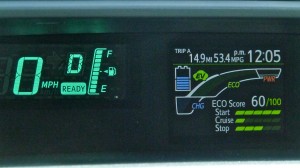
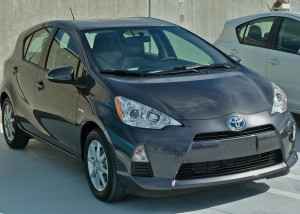
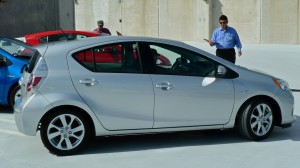
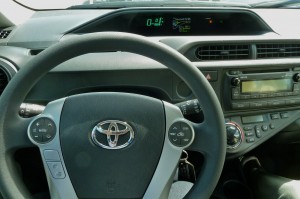
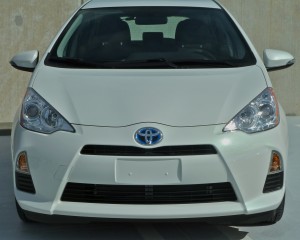
 John Gilbert is a lifetime Minnesotan and career journalist, specializing in cars and sports during and since spending 30 years at the Minneapolis Tribune, now the Star Tribune. More recently, he has continued translating the high-tech world of autos and sharing his passionate insights as a freelance writer/photographer/broadcaster. A member of the prestigious North American Car and Truck of the Year jury since 1993. John can be heard Monday-Friday from 9-11am on 610 KDAL(www.kdal610.com) on the "John Gilbert Show," and writes a column in the Duluth Reader.
John Gilbert is a lifetime Minnesotan and career journalist, specializing in cars and sports during and since spending 30 years at the Minneapolis Tribune, now the Star Tribune. More recently, he has continued translating the high-tech world of autos and sharing his passionate insights as a freelance writer/photographer/broadcaster. A member of the prestigious North American Car and Truck of the Year jury since 1993. John can be heard Monday-Friday from 9-11am on 610 KDAL(www.kdal610.com) on the "John Gilbert Show," and writes a column in the Duluth Reader.